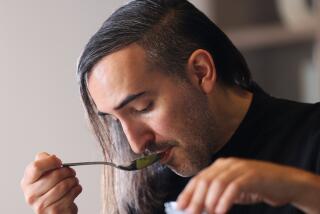Chef in ‘Hundred-Foot Journey’ serves up a feast for the eyes

- Share via
When chef Floyd Cardoz arrived in France last year, he knew he’d spend most of his time cooking. What he didn’t expect was a quest for the perfect Hollywood shot that would force him to roast a wild bird artfully stuffed with truffles — 12 times.
“I asked someone, ‘Do you really need this amount of food?’” Cardoz said. “There were takes and retakes, and a lot of the food just gets thrown out. For me, that was a learning experience.”
Cardoz spent five days working elbow-to-elbow with eight other chefs on “The Hundred-Foot Journey,” which opens Friday. As culinary consultant, he was asked to create the sumptuous buffet of gastro-porn seen throughout the film.
“The Hundred-Foot Journey” joins “Big Night,” “Babette’s Feast,” Jon Favreau’s recent “Chef” and other foodie-friendly films — this one rife with close-ups of beautifully plated boeuf bourguignon and freshly baked baguettes. Even if you can’t name the five mother sauces of French cooking, you may find yourself breathing heavily during scenes of glistening grilled meat, wild mushrooms, simmering curries and snow-white béchamel sauce.
Directed by Lasse Hallström, the man who had audiences swooning in 2000 over “Chocolat,” and based on the bestselling novel by Richard C. Morais, “The Hundred-Foot Journey” is the story of a young Indian chef named Hassan Kadam, played by Manish Dayal, on his quest to become a culinary Mozart.
After a series of unfortunate circumstances, Kadam and his family, led by Papa (Om Puri), settle in Saint-Antonin-Noble-Val in France, where they open a traditional Indian restaurant. They happen to be exactly 100 feet across the road from a Michelin-starred classic French restaurant run by a stiff Madame Mallory, played by Helen Mirren.
On one side of the road, Madame Mallory takes pride in a formal world of starched linen, heavy cream, fine wine and perfectly shined cutlery. You are not to eat with your hands unless it is to hold a slice of baguette.
On the other side, Kassan sets up shop with a faux Taj Mahal façade, murgh masala, plastic place mats and a blaring boombox. Eating with your hands is expected.
Cardoz found that the story echoed his own: The Indian-born chef came to the United States in the late ‘80s but struggled to find work. He was finally given a chance by Gray Kunz, who at the time was chef at Lespinasse at the St. Regis in Manhattan.
Cardoz eventually became executive chef at Tabla, a since-closed Indian restaurant in New York where he met Morais. The author had researched his book by traveling the globe and spending time in the kitchens of such legendary restaurants as Le Bernardin in New York as well as Crawford Market in Mumbai. But he was still searching for a culinary consultant who understood the story behind the food.
Morais sent Cardoz a copy of his book, and the author knew he’d found the right ambassador when he received an email back that said: “This is my story.”
“He said, ‘It’s like I whispered them in your ears and you wrote them down,’” Morais recalled.
No food stylists were used to prepare the food in the film. Instead, the filmmakers hired Cardoz as well as a classically trained French chef, an Indian chef who had cooked in France and an expert in molecular gastronomy, among other professionals.
“For me, it was about cooking real food, not fake food,” Cardoz said. “Everything we did was real, so if anyone wanted to eat it, they could.”
Tasked with bringing recipes in the book to life, Cardoz thought about what would look good on camera, then went about creating a menu.
“I’m so passionate and connected to Indian flavors that it didn’t take me very long to develop the recipes,” Cardoz said. “When I cook at home, I cook in that style, and when I make dishes, it’s all about how I can make food sing for people.”
Drawing from his experience at Tabla and at North End Grill in New York, Cardoz put his stamp on classically French dishes. To boeuf bourguignon he added ginger, Aleppo pepper and cumin; his fluffy omelet is spiced with coriander. His take on the grilled, yogurt-marinated chicken tikka and his succulent stuffed pigeon with truffles are also highlighted in the film.
But filmmakers didn’t just want the food to act as a metaphor for bridging two cultures. Juliet Blake, who produced the film (along with Steven Spielberg and Oprah Winfrey, among others), wanted it to be a feast for the eyes.
“What we wanted to do was leave the audience really wanting to taste the wonderful Indian and French food in the film,” Blake said.
“The thing about food is that it doesn’t just combine different recipes, it can combine different cultures,” she said. “Food is a great leveler of people, and everyone loves watching food.”
Twitter: @Jenn_Harris_
Corrected: An earlier version of this post misstated Gray Kunz’s first name as Greg.
More to Read
Only good movies
Get the Indie Focus newsletter, Mark Olsen's weekly guide to the world of cinema.
You may occasionally receive promotional content from the Los Angeles Times.











